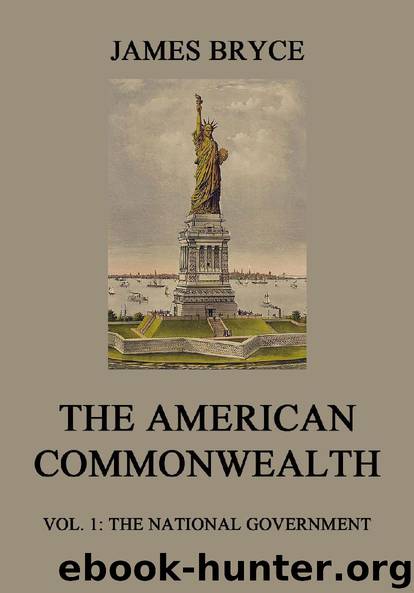The American Commonwealth: Vol. 1: The National Government by James Bryce

Author:James Bryce [Bryce, James]
Language: eng
Format: epub
Tags: Politikwissenschaft
Publisher: Jazzybee Verlag
Published: 2017-08-10T22:00:00+00:00
CHAPTER XXII. THE FEDERAL COURTS
When in 1788 the loosely confederated States of North America united themselves into a nation, national tribunals were felt to be a necessary part of the national government. Under the Confederation there had existed no means of enforcing the treaties made or orders issued by the Congress, because the courts of the several States owed no duty to that feeble body, and had little will to aid it. Now that a Federal legislature had been established, whose laws were to bind directly the individual citizen, a Federal judicature was evidently needed to interpret and apply these laws, and to compel obedience to them. The alternative would have been to entrust the enforcement of the laws to State courts. But State courts were not fitted to deal with matters of a quasi-international character, such as admiralty jurisdiction and rights arising under treaties. They supplied no means for deciding questions between different States. They could not be trusted to do complete justice between their own citizens and those of another State. Being under the control of their own State governments, they might be forced to disregard any Federal law which the State disapproved; or even if they admitted its authority, might fail in the zeal or the power to give due effect to it. And being authorities co-ordinate with and independent of one another, with no common court of appeal placed over them to correct their errors or harmonize their views, they would be likely to interpret the Federal Constitution and statutes in different senses, and make the law uncertain by the variety of their decisions. These reasons pointed imperatively to the establishment of a new tribunal or set of tribunals, altogether detached from the States, as part of the machinery of the new government. Side by side of the thirteen (now forty-four) different sets of State courts, whose jurisdiction under State laws and between their own citizens was left untouched, there arose a new and complex system of Federal courts. The Constitution drew the outlines of the system. Congress perfected it by statutes; and as the details rest upon these statutes, Congress retains the power of altering them. Few American institutions are better worth studying than this intricate judicial machinery: few deserve more admiration for the smoothness of their working: few have more contributed to the peace and well-being of the country.
The Federal courts fall into three classes: —
The Supreme court, which sits at Washington.
The Circuit courts.
The District courts.
The Supreme court is directly created by Art. iii. § 1 of the Constitution, but with no provision as to the number of its judges. Originally there were six; at present there are nine, a chief justice, with a salary of $10,500 (£2100), and eight associate justices (salary $10,000). The justices are nominated by the President and confirmed by the Senate. They hold office during good behavior, i.e. are removable only by impeachment; and have thus a tenure even more secure than that of English judges, for the latter may be removed by the Crown on an address from both Houses of Parliament.
Download
This site does not store any files on its server. We only index and link to content provided by other sites. Please contact the content providers to delete copyright contents if any and email us, we'll remove relevant links or contents immediately.
Beautiful Disaster by McGuire Jamie(25252)
Trainspotting by Irvine Welsh(21519)
Call Me by Your Name by André Aciman(20373)
The Secret History by Donna Tartt(18847)
All the Missing Girls by Megan Miranda(15575)
Cat's cradle by Kurt Vonnegut(15186)
Pimp by Iceberg Slim(14394)
Norse Mythology by Gaiman Neil(13207)
The Tidewater Tales by John Barth(12608)
4 3 2 1: A Novel by Paul Auster(12284)
Scorched Eggs by Childs Laura(11313)
The Break by Marian Keyes(9307)
Adultolescence by Gabbie Hanna(8857)
The remains of the day by Kazuo Ishiguro(8822)
Never let me go by Kazuo Ishiguro(8711)
Where the Crawdads Sing by Delia Owens(8517)
All the Light We Cannot See: A Novel by Anthony Doerr(8434)
A Man Called Ove: A Novel by Fredrik Backman(8371)
Circe by Madeline Miller(8012)
